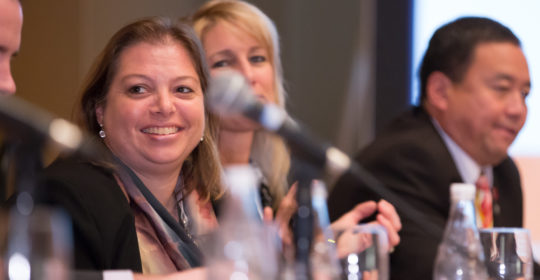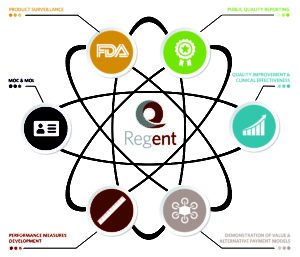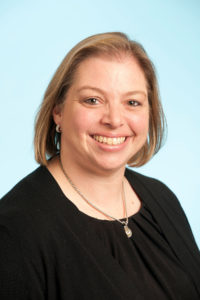
AAO-HNS Board of Governors Seeks to Increase Membership Engagement with Leadership Development, Data Registry and Diversity
 The American Academy of Otolaryngology‒Head and Neck Surgery (AAO-HNS) is the world’s largest organization of specialists who treat the ear, nose, throat, and related structures of the head and neck. Its advocacy efforts have ranged from encouraging hearing tests in 1924 to examining the effect of managed care on members in the 1980s.1 This broad-based focus is in line with the goals of Stacey Ishman, MD, MPH, the chair-elect of the Board of Governors (BOG) of the AAO‒HNS, clearly defined: “Continue our leadership development momentum; determine, with our membership’s input, what should be included in our clinical data registry; and be more cognizant of diversity among our membership.” Dr. Ishman, who assumes the chair in October 2016, is surgical director of the upper airway center, director of otolaryngology outcomes research and associate professor of otolaryngology – head and neck surgery and pulmonary medicine at Cincinnati Children’s Hospital Medical Center. The 250-member BOG comprises local, state, specialty, and national otolaryngology‒head and neck surgery societies, and is a conduit of information between the board of directors, the executive committee, and the approximately 12,000 member base.
The American Academy of Otolaryngology‒Head and Neck Surgery (AAO-HNS) is the world’s largest organization of specialists who treat the ear, nose, throat, and related structures of the head and neck. Its advocacy efforts have ranged from encouraging hearing tests in 1924 to examining the effect of managed care on members in the 1980s.1 This broad-based focus is in line with the goals of Stacey Ishman, MD, MPH, the chair-elect of the Board of Governors (BOG) of the AAO‒HNS, clearly defined: “Continue our leadership development momentum; determine, with our membership’s input, what should be included in our clinical data registry; and be more cognizant of diversity among our membership.” Dr. Ishman, who assumes the chair in October 2016, is surgical director of the upper airway center, director of otolaryngology outcomes research and associate professor of otolaryngology – head and neck surgery and pulmonary medicine at Cincinnati Children’s Hospital Medical Center. The 250-member BOG comprises local, state, specialty, and national otolaryngology‒head and neck surgery societies, and is a conduit of information between the board of directors, the executive committee, and the approximately 12,000 member base.

Regent℠ is an otolaryngology-specific clinical data registry that will become the foundation for quality reporting, measures development, quality improvement, clinical and product research, and support for maintenance of certification and licensure.
According to Dr. Ishman, leadership development is ongoing through communication with local, state, and regional societies, and she encourages members to become involved. “RegentSM, the first otolaryngology-specific clinical data registry, will enable us to answer questions from a research perspective,” says Dr. Ishman, as well as provide payment information for members, Centers for Medicare and Medicaid Services (CMS), and private payers.2 Additionally, the registry will be the basis for quality reporting (on quality measures for federal and private programs), quality improvement (using longitudinal data to identify gaps in performance and care), patient outcomes, clinical research, and maintenance of certification and licensure. The AAO-HNS registry was recently accepted as a qualified clinical data registry (QCDR) with CMS, which will position it well for the anticipated CMS merit-based incentive program. The pilot phase has begun and will run through late summer/early fall.
Regarding diversity, “we want to look like our patients, and we want patients and colleagues to feel we are representing them,” says Dr. Ishman. The AAO-HNS diversity statement acknowledges “that culturally effective care is predicated on cultural sensitivity and cultural competence. The Academy affirms its dedication to diversity by ensuring and developing opportunity for leadership positions within the Academy that are accessible to all Fellows, including underrepresented minorities within our specialty.” 3
Tactics for better engagement with society members include a common resource set and a “virtual society.” The common resource set comprises “how to’s,” as Dr. Ishman calls them, such as how to run a meeting, how to encourage membership involvement, and other organizational essentials. Dr. Ishman looks forward to making this and other information available online. The virtual society is a recent initiative that Ishman wants to continue and expand. In a geographically large state like Wyoming, for example, “it’s hard for our members to meet frequently in one location,” she explains. Through Skype or a similar platform, many can gather electronically without having to travel, making monthly meetings and an exchange of information more likely.
According to Dr. Ishman, not all members may be aware of the BOG’s legislative advocacy efforts and those of the AAO-HNS board of directors, such as joining with other medical organizations to repeal the sustainable growth rate (SGR) formula in 2015. The SGR was a method used by CMS to control spending by Medicare on physician services. If the repeal bill had not been approved, CMS was scheduled to start processing Medicare payments for physician services at a rate reduced by 21.2%.4 Economic issues will continue to be important for AAO-HNS with the push for alternative payment models and requirements for physician reporting. As Dr. Ishman says, “We need to find ways to fit specialists into the new payment models while taking the best care of our patients.”
References:
- AAO‒HNS. About us. Available at http://www.entnet.org/content/about-us. Accessed April 13, 2016.
- AAO‒HNS. ENT clinical data registry. Available at http://www.entnet.org/content/otoregistry. Accessed April 11, 2016.
- AAO‒HNS. Statement on diversity. Available at http://www.entnet.org/content/diversity. Accessed April 11, 2016.
- AAO‒HNS. AAO‒HNS applauds Senate for passage of SGR repeal. Available at http://www.entnet.org/content/aao-hns-applauds-senate-passage-sgr-repeal. Accessed April 11, 2016.
 Stacey Ishman, MD, MPH
Stacey Ishman, MD, MPH
Surgical Director, Upper Airway Center
Director of Otolaryngology Outcomes Research
Associate Professor
Departments of Otolaryngology & Pulmonary Medicine
Cincinnati Childrens Hospital Medical Center
513-636-4356
Stacey.Ishman@cchmc.org
Connect with Stacey Ishman, MD, MPH on Doximity
Leave a reply →

